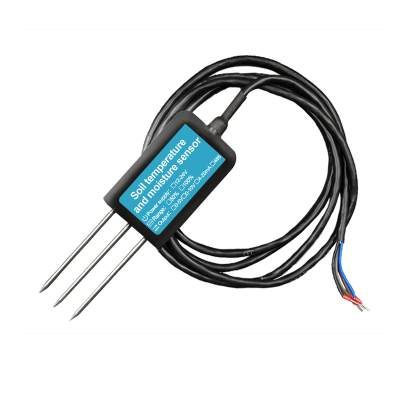In the ever-evolving landscape of modern agriculture, precision farming has emerged as a game-changer, leveraging cutting-edge technology to optimize crop yields, conserve resources, and minimize environmental impact. At the heart of this agricultural revolution are soil sensors, sophisticated devices designed to provide farmers with real-time data about their fields. These sensors are transforming farming practices, enabling farmers to make informed decisions based on accurate, instantaneous information rather than relying on intuition or historical data. This article delves into the significance of soil sensors in precision farming, exploring their functionality, benefits, and the broader implications for sustainable agriculture.

The Evolution of Precision Farming
Precision farming, also known as smart farming or site-specific crop management, involves the use of technology to monitor, manage, and optimize crop production. Traditional farming methods often relied on broad generalizations and manual labor, which could lead to inefficiencies and resource wastage. With the advent of global positioning systems (GPS), remote sensing, drones, and, notably, soil sensors, precision farming has become a data-driven endeavor.
Soil sensors are instruments embedded in or near the soil that measure various physical, chemical, and biological properties. These properties include moisture content, temperature, electrical conductivity (indicating salinity), pH levels, nutrient availability, and even soil compaction. By collecting this data continuously, soil sensors provide farmers with a comprehensive picture of their field’s health and needs, allowing for tailored management strategies.
The Functionality of Soil Sensors
Soil sensors utilize a variety of technologies to gather data. Some sensors work on the principle of capacitance, measuring the soil’s ability to hold an electrical charge, which is related to moisture content. Others employ electromagnetic induction to assess soil salinity and texture. Optical sensors can detect changes in soil color, which can indicate nutrient deficiencies or organic matter content. More advanced sensors use spectrometry to analyze the chemical composition of the soil.
The data collected by these sensors is transmitted wirelessly to a central hub, such as a smartphone, tablet, or computer. Farmers can then access this information in real-time, enabling them to monitor soil conditions remotely and make immediate adjustments to their farming practices. Many systems also offer predictive analytics, using historical data and machine learning algorithms to forecast future soil conditions and crop performance.
Benefits of Soil Sensors in Precision Farming
- Optimized Water Management:
Soil moisture sensors are perhaps the most widely used type of soil sensor. By monitoring soil moisture levels continuously, farmers can irrigation schedules that match the actual needs of their crops. This not only conserves water but also ensures that plants receive the optimal amount of moisture, promoting healthier growth and higher yields. - Nutrient Management:
Sensors that measure soil nutrient levels, such as nitrogen, phosphorus, and potassium, enable farmers to apply fertilizers precisely where and when needed. This reduces over-fertilization, which can lead to nutrient runoff and water pollution, and saves money by minimizing waste. - Soil Health Monitoring:
Understanding the pH level and compaction of soil is crucial for maintaining soil health. Sensors that monitor these parameters help farmers identify areas prone to compaction or acidification, allowing them to take corrective actions such as liming or tillage. - Disease and Pest Management:
Although primarily focused on soil properties, some sensors can also detect early signs of soil-borne diseases and pests. By catching problems early, farmers can implement control measures before they spread, protecting their crops and minimizing losses. - Increased Crop Yields and Quality:
The combination of optimized water and nutrient management, coupled with improved soil health, leads to higher crop yields and better quality produce. This not only benefits farmers economically but also contributes to global food security. - Environmental Sustainability:
Precision farming practices facilitated by soil sensors reduce the use of chemicals and water, minimizing the environmental footprint of agriculture. This aligns with the goals of sustainable agriculture, which aims to meet the food needs of the present without compromising the ability of future generations to meet theirs.
Challenges and Future Directions
Despite their many benefits, the adoption of soil sensors in precision farming faces several challenges. The initial cost of installing and maintaining a network of sensors can be prohibitive for small-scale farmers. Additionally, the technology requires a level of digital literacy that may not be widely available in some agricultural communities.
Efforts are underway to address these challenges. Governments and non-profit organizations are offering subsidies and training programs to encourage the adoption of precision farming technologies. Researchers are also developing more affordable, user-friendly sensors and data platforms to broaden access.
Looking ahead, the integration of soil sensors with other precision farming technologies, such as drones and satellite imagery, holds promise for even greater efficiencies. The development of Internet of Things (IoT) systems that can communicate seamlessly across devices will further enhance the capabilities of precision farming.
Moreover, as artificial intelligence and machine learning algorithms become more sophisticated, soil sensors will play an increasingly critical role in predictive analytics. By analyzing historical data and identifying patterns, these algorithms can forecast soil conditions and crop performance with unprecedented accuracy, guiding farmers toward even more precise management decisions.
Conclusion
Soil sensors are at the forefront of the precision farming revolution, providing farmers with real-time data that empowers them to manage their fields with unprecedented precision. By optimizing water and nutrient use, monitoring soil health, and detecting early signs of pests and diseases, these sensors are driving increases in crop yields, improving produce quality, and reducing the environmental footprint of agriculture.
As the technology continues to evolve and become more accessible, the potential for soil sensors to transform farming practices globally is immense. By embracing precision farming technologies, farmers can contribute to a more sustainable, resilient, and productive agricultural sector, ensuring food security for current and future generations. The journey toward smarter, data-driven farming has only just begun, and soil sensors are leading the way.